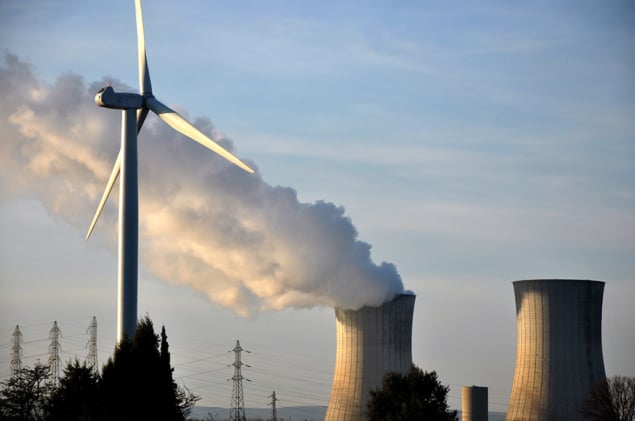France has some quite ambitious renewable energy targets, coupled with a partial nuclear phase-out policy, but progress has been a little patchy. Dave Elliott reports

Although progress has been relatively slow, France has a quite ambitious energy policy. Nuclear is to be cut back by around 25% by 2025, so that it supplies a maximum of 50% of power, with renewables accelerating to supply 32% of energy by 2030 and doubling their share of electricity to 40% by then. Last year, according to BNEF data, France invested $5bn in clean energy, up 15% on 2016.
It has some interesting renewable energy projects at a range of scales. For example, the go-ahead has been given for 17 GW of small-scale renewables. At the larger scale, a 493 MW offshore wind farm also got the go-ahead off Brittany – its biggest offshore project so far. France has also launched its first floating wind turbine – a 2MW Floatgen “damping pool” unit.
However, it is still some way from reaching its EU-agreed target of getting 23% of its energy from renewables by 2020. Progress has been slowed by bureaucratic constraints and policy shifts. But the problems are gradually being addressed. For example, the government now has a 10-point plan to simplify admin procedures to boost wind so it can double its capacity to 26 GW by 2023. It hopes to halve the time taken to process wind farm applications: some have been opposed locally and some, for offshore sites, can take up to nine years.
Detailed overall plans are still hard to come by, but recent PPE (Plan de programmation pluriannuelle de l’Energie) targets imply total renewable-energy capacity of 70 GW (low scenario) – 77 GW (high scenario) by 2023, delivering 150 and 167 TWh of electricity per year respectively, and increased annual installation rates from 1 to 2 GW for solar, and from 1 to 1.8 GW for wind (though less offshore than expected), as part of the overall goal of increasing renewables share to 23% of gross energy consumption in 2020, on the way to 32% by 2030.
An earlier study by the French environment and energy agency Ademe had claimed that it would be in theory possible to supply all electricity with renewables by 2050. It looked to a mix of 63% off and onshore wind, 17% solar, 13% hydro, and 7% thermal energy (including geothermal). EDF thought this was somewhat optimistic.
Initially it looked as if Macron, the new president, would back an ambitious renewables programme and the nuclear partial phase-out, especially given the appointment of a strongly pro-renewables energy and environment minister. However, after a long delay, the new Macron-led government has now made some adjustments – perhaps following a campaign by the pro-nuclear lobby, including input from the Energy for Humanity group. The partial nuclear phase-out plan has been delayed by five years, maybe more, since it was argued that renewables couldn’t expand fast enough. But this may only be a short-term pause; the aim is still to push renewables strongly. The government it seems may make state-owned utility company EDF shift its focus from nuclear to renewables. Minister Nicholas Hulot says cash-strapped EDF “can revitalize itself through renewables”.
For its part, EDF says it will install 30 GW of PV solar between 2020 and 2035, pushing PV’s input up to 6% of EDF’s total. EDF says that PV is easier to deploy, since there has been resistance to some wind projects, even though, by 2017, France did have around 12 GW of wind, against only about 8 GW of PV. Nevertheless, EDF does seem keen to push all renewables. It’s also supporting offshore marine energy, for example backing Open Hydro’s tidal turbine.
As elsewhere in the EU, while green electricity supply is doing quite well, the heat side has been less successful. However, French utility Engie plans to switch all its gas operations to biogas/renewable hydrogen by 2050, making it 100% green. Engie has 70 biogas projects globally, including 40 in France. It estimates that biogas from farm and other waste – but not using food crops – has the potential to grow from about 1% of gas use in France to 10% by 2025, 30% by 2030 and 100% by 2050. It also wants to produce hydrogen gas with solar by the electrolysis of water at a price that would make it more competitive with steam reforming of hydrocarbons, which accounts for 95% of hydrogen produced today and costs about €2/ kilo, compared to €6/kilo for electrolysis. But it may do that overseas, e.g. in Chile where it has a market base.
In the meantime, France is still faced with its ageing nuclear fleet. Despite the nuclear phase-out delay, the government still aims to shut the old Fessenheim plant and any others that the Nuclear Safety Authority considers dangerous. But it also wants to upgrade the rest, extending their usable life. This may not be easy given the high cost and the financial and technical problems EDF is facing.
EDF’s much-delayed new Flamanville EPR seems to be beset with endless problems. EDF and Avera have certainly had a bad few years with technical crises. For example, the nuclear safety regulator has asked EDF to examine the manufacturing records of all components produced by the Avera Creusot forge in use at its operating nuclear power plants, and other problems have evidently also now emerged, with further delays likely due to welding faults. It has clearly been a long and costly struggle to get this plant built and no further new plants seem likely, unless heavily subsidised.
Given this backdrop, with at one time many of France’s nuclear plants also closed for safety checks, it does seem odd that Macron chose to portray renewables as being unable to take the strain. Macron has been quoted as saying “A large drop in nuclear capacity can’t be immediately compensated by renewables, because solar and wind are intermittent. As distribution networks stand, we can’t replace several gigawatts of nuclear by equivalent amounts of wind or solar. With current technology, the only way to shut down reactors massively would be, as the German case clearly shows, to open thermal or coal, or rely on foreign gas.”
This may be a little disingenuous. Germany does use coal still, but it exports some of its surplus power to France, some of that surplus being due to the success of renewables, with over 100 GW of wind and PV installed so far. The planned 25% nuclear phase-out in France could hopefully have worked if renewables had been accelerating faster there too, going well beyond the 45 GW it had at the end of 2016. They weren’t, so now the nuclear phase-out has been delayed, with, it might be argued, inflexible nuclear still in effect blocking progress with renewables, despite claims that nuclear can ramp up and down more.
France does seem to be making heavy weather of its energy transition, but that was perhaps inevitable given its huge nuclear element. Germany had much less and is managing to phase that out reasonably well, although, as Macron notes, not without some issues. See my next post on Germany – its coal use has actually been falling.
Meanwhile, back in France, looking to the far future, ITER, the €20bn 500 MW international fusion test plant in the south of France, is half built. But it will be a big net power user – not “10 times more out than in”, as was claimed. A way to go then before fusion might be a serious contender in France or anywhere else. See my separate article on fusion and this very cautious look at ITER and what might follow it, stressing the safety problems.



